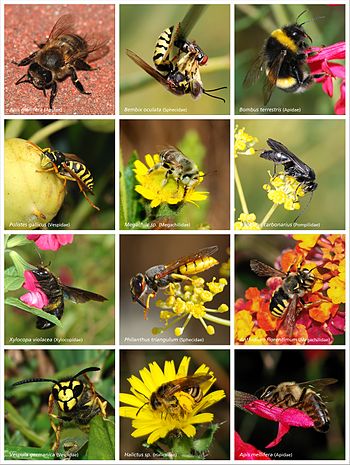 |
| Bees and wasps (Photo credit: Wikipedia) |
A lean man past middle age, Francisco Cerda still goes to work most days of the week at a limestone quarry in Las Mercedes, an area of the Paso del Istmo near the Costa Rican border.
His house is rustic and similar to many in the region.
Approaching it, we pass a well, an outdoor shower, and a large basin for washing clothes.
Scrawny dogs lie sprawled on the ground, and chickens peck at insects in the shade of a mango tree.
The house´s walls are made of rough boards with large cracks, and the smell of wood smoke drifts from the kitchen.
Our eyes are drawn to dark specks darting in and out of logs
hanging horizontally from the eaves of the house´s metal roof. They are
bees, and they are why we are here.
Francisco owns hives of jicote manso, a species of stingless bee that has been kept by people in Central America for millennia. The word jicote comes from the Nahuatl word xicotl (meaning bee or wasp, and manso means
docile in Spanish).
Francisco used to have over forty hives, but when
violence broke out in the region during the 1970s, his family immigrated
to Costa Rica, leaving the bee colonies behind. When Francisco returned
home after the war, only about five hives remained.
Today, he cherishes those hives, marking the age of each hive by
the birth dates of his grown children. Stingless bee honey is
traditionally given to pregnant women as their due dates approach, maybe
as a nutritional supplement or maybe just as a sweet indulgence!
My coworker Marcos and I have been visiting Francisco´s home every
week since the end of January, expressing Paso Pacifico´s interest in
conserving native bees, explaining the process for dividing hives, and
catching bees in Ziploc baggies in order to collect pollen samples from
them.
Initially, Francisco seemed skeptical about our project, but it
soon became clear that the maintenance of stingless bee populations was a
concern that we shared.
Francisco has noted the increasing scarcity of jicote manso,
attributing the population decline to the conversion of forest to teak
plantations and the proliferation of both feral and domesticated
Africanized honey bees.
His hypotheses are quite plausible, likely
compounded by pesticide use and overharvesting of honey from the forest.
The plight of bees likely sounds familiar to you; with some
regularity, we read in the news about colonies collapsing and fruit
orchards being left without pollinators.
Honey bees support many
livelihoods and pollinate many crops, but with thousands of bee species
in the Americas, it is shortsighted to focus exclusively on the
preservation of honey bees.
Reliance on a single pollinator species
makes us vulnerable, and honey bees are not great pollinators for all
plants. For example, they do not perform buzz pollination, a mechanism
needed by crops such as tomatoes.
At the very end of March, Francisco, Marcos, and I moved a colony of jicote manso from
a rotting log hive to a brand new box hive. The brood combs were of
modest size, but so far it seems that the bees are adapting well to
their new home. Perhaps by working with them, we can build our
resilience together.

No comments:
Post a Comment